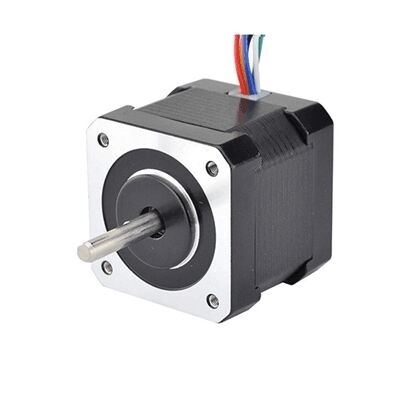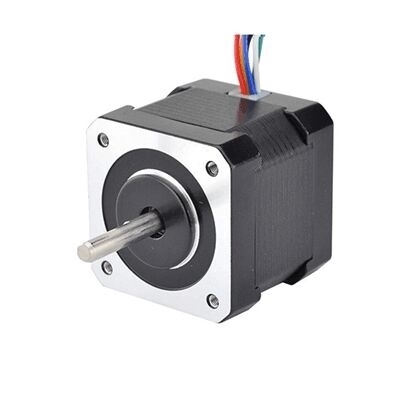- Home
-
Motors
-
Motor Controls
- Power Supplies
-
Passive Components
- Back
- Relays
- Contactors
- Circuit Breakers
- Capacitors
- Connectors
- Filters
- Push Button
- Pressure Switch
-
Potentiometer
- Back
- Rotary Potentiometer
-
Resistor
- Back
- Metal Film Resistor
- Transfer Switches
- Current Transformer
- DIP Switch
- Electronic Ballast
- Foot Switch
- Forward Reverse Switch
- Float Valves
- Fuse
- Hook-Up Wire
- Isolator Switch
- Indicator Light
- Junction Box
- Joystick Switch
- Knife Switch
- Locking Plugs
- LED Machine Light
- Low Noise Amplifiers
- Laser Module
- Micro Switch
- Magnetic Starter
- Over Voltage Protector
- PV Combiner Box
- Potential Transformer
- Rotary Switch
- Rocker Switch
- RF Attenuators
- Rectifier
- Surge Protection Devices
- Terminal Block
- Toggle Switch
- Tact Switch
- Timer Switch
-
Sensors
- Back
- Encoder
- Proximity Sensor
- Temperature Sensor
- Level Sensor
- Accelerometer Sensor
- Angle Sensor
- Current Sensor
- Compass Sensor
- Displacement Sensor
- Flow Switch
- Float Switch
- Gyroscope Sensor
- Gas Sensor
- Inclinometer Sensor
- Ion Selective Electrode
- Load Cell
- Limit Switch
- Laser Sensor
- Light Curtain
- Magnetic Cylinder Sensor
- Noise Sensor
- pH Electrode
- Pressure Sensor
- PM Sensor
- Photoelectric Sensor
- Radiation Sensor
- Reference Electrode
- Rain Sensor
- Signal Isolator
- Safety Switch
- Strain Gauge
- Speed Sensor
- Soil Moisture Sensor
- Temperature and Humidity Sensor
- Torque Sensor
- Ultrasonic Sensor
- Voltage Sensor
- Vibration Transmitters
- Water Leakage Sensor
- Water Quality Sensor
-
Test & Measurement
- Back
- Gas Detectors
- Micrometers
- Oscilloscopes
- Pressure Gauge
- Protractor
- Thickness Gauge
- Turbidity Meter
- Anemometer
- Air Quality Monitor
- Clamp Meter
- Crane Scale
- Colorimeter
- Current Transformer Tester
- Conductivity Meter
- Digital Panel Meter
- Digital Counter
- Digital Readout
- Dew Point Meter
- Digital Inclinometer
- Digital Torque Adapters
- Density Meter
- Distance Meter
- Dynamometer
- Digital Tachometer
- Digital Indicator
- Dielectric Oil Tester
- Digital Manometer
- Diameter Gauge
- Energy Meter
- Earth Resistance Tester
- Electronic Analytical Balance
- Electronic Load
- Electronic Compass
- Flow Meters
- Function Generator
- Force Gauge
- Feeler Gauges
- Gloss Meter
- Gauss Meter
- Hipot Tester
- Hardness Tester
- Height Gauges
- Handheld Ultrasonic Homogenizer
- Infrared Thermometers
- Insulation Tester
- Linear Scale
- LCR Meter
- Laser Levels
- Lux Meter
- Land Meter
- Moisture Meter
- Multimeter
- Metal Detector
- Measuring Wheel
- Measuring Tapes
- Nuclear Radiation Detector
- Network Cable Tester
- Optical Time Domain Reflectometer
- Oil Tank Gauge Tape
- pH Meter
- Paperless Recorder
- Particle Counter
- Power Meter
- Power Meter Plug
- Pipe Blockage Detector
- Particle Size Analyzer
- Relay Tester
- Refractometer
- Rebound Hammer
- Rebar Scanner
- Spectrophotometers
- Sound Level Meter
- Smoke Detector
- Solar Power Meter
- Surface Roughness Tester
- Signal Generator
- Stud Finder
- Temperature Controller
- Temperature Data Logger
- Tension Meters
- USB Tester
- Viscometer
- Vibration Meter
- Vernier Caliper
- Volt Amp Meter
- Water Quality Tester
- Water Leakage Detectors
-
Transmission & Actuator
- Back
- Brakes and Clutches
- Ball Valves
- Butterfly Valves
- Bearings
- Check Valves
- Control Valves
- Gearbox
- Globe Valves
- Gate Valves
- Hydraulic Cylinders
- Needle Valves
- Pressure Regulator
- Pressure Relief Valves
- Solenoid Valves
- Shaft Coupling
- Strainers
- Valve Actuators
- Air Filters
- Air Hose Fittings
- Angle Seat Valves
- Door Opener
- Drag Chain
- Diaphragm Valves
- FRL Unit
- Filling Valve
- Hydraulic Actuator
- Hand Valves
- Hydraulic Accumulators
- Linear Actuators
- Linear Slide
- Linear Rail
- Pneumatic Cylinders
- Pneumatic Foot Pedal
- Plug Valves
- Pinch Valves
- Plunger Valves
- Pulse Valves
- Quick Connector
- Quick Exhaust Valves
- Slip Ring
- Steam Traps
- Shuttle Valves
- Torque Limiters
- Universal Couplings
- Vacuum Generator
-
Pumps
- Back
- Booster Pump
- Centrifugal Pump
- Diaphragm Pump
- Hydraulic Pump
- Lubrication Pump
- Vacuum Pump
- Well Pump
- Aerator Pump
- Bilge Pump
- Dosing Pump
- Fire Pump
- Gear Pump
- Hot Oil Pump
- Lobe Pump
- Magnetic Drive Pump
- Mud Pump
- Peristaltic Pump
- Piston Pump
- Pool Pump
- Rotary Hand Pump
- Screw Pump
- Self Priming Pump
- Sewage Pump
- Sliding Vane Pump
- Wing Pump
-
Tools
- Back
- Blower
- Centrifuge Machine
- Circular Saws
- Desoldering Tool
- Generator
- Glass Lined Reactor
- Hoist
- Jack
- Plate Clamp
- Rebar Tool
- Soldering Tool
- Winch
- Alarm & Siren
- Beam Trolley
- Beam Clamp
- Cable Cutter
- Crimping Tool
- DC Cooling Fan
- Endoscope
- Electric Pressure Washer
- Foam Cutter
- Flange Spreader
- Flashlight
- Heat Exchanger
- Hydraulic Punch
- Heat Gun
- Hydraulic Puller
- Hydrothermal Synthesis Reactor
- Impact Wrenches
- Inkjet Printer
- Lifting Hook
- Labour Protection Appliance
- Magnetic Stirrer
- Magnetic Sweepers
- Portable LED Work Light
- Pipettes
- Pneumatic Screw Driver
- Pneumatic Drill
- Pipe Bender
- Rubber Sheets
- Reciprocating Saw
- Rotary Evaporator
- Sander
- Screw Feeder
- Snatch Block
- Spring Balancer
- Strapping Tool
- Wire Stripper
-
Communication & Controller
-
Industrial Equipment
- Back
- Air Compressors
- Chamfering Machines
- CNC Router Machine
- Dryer
- Dehumidifier
- Fume Extractor
- Fan Heater
- Industrial Cameras
- Industrial Vacuum Cleaner
-
Laser Machines
- Back
- Laser Marker
- Oil Mist Eliminators
- SCARA Robot
- Static Eliminator
- Steam Autoclave Sterilizer
- Tool Setter
- Ultrasonic Cleaner
- Water Chiller
- Welding Machine
- Water Purification System
- Technical Support
- How To Buy
- Contact
- Chat
- ATO /
- Motors /
- Stepper Motors /
- NEMA 17 Stepper Motors
NEMA 17 Stepper Motors
Nema 17 Stepper motor, 12V 0.4A, 1.8 degree, 2 phase 6 wires
Nema 17 Stepper motor for 3D Printer, 12V 0.4A, 2 phase 6 wires
ATO Nema 17 stepper motor is a hybrid bipolar stepper motor with an end face size of 1.7 inches x 1.7 inches (42mm x 42mm). 2 phase permanent magnet stepper motor draws 0.8 to 2 amp, allowing for holding torque of 0.16N·m to 0.65N·m, simple structure, small size and easy to mount. 2A closed loop electric stepper motor allows for holding torque of 0.40N·m to 0.72N·m. The high torque motor has four color-coded wires, a 1.8 degree step angle and a 5mm shaft at factory price. These low cost stepper motors can be controlled by AC or DC digital stepper drivers for precise position control. Widely used in 3D printers, CNC routers, robot arms, sewing machines, engraving machines, film cutting machines and other equipment.
3 drive modes of Nema 17 stepper motor

The Nema 17 stepper motor has three basic drive modes, including full-step, half-step, and subdivision. The main difference lies in the control accuracy of the motor coil current, that is, the excitation method. Usually, stepper motors have the characteristics of low-frequency vibration, and the balance of low-speed operation of the motor can be improved through subdivision and coordination.
Full-step drive
In full-step operation, the same stepper motor can be equipped with either full or half-step drivers or subdivision drivers, but the operating effects are different. The stepper motor driver cyclically excites the two coils of the two-phase stepper motor according to the pulse or direction command (that is, the coil is charged to set the current), and each pulse of this driving method will move the motor by a basic step angle, that is, 1.80 degrees (a standard two-phase motor has a total of 200 step angles in one revolution).
Half-step drive
During single phase excitation, the motor shaft stops at the full-step position. After the driver receives the next pulse, if it is excited to another phase and remains in the original excitation state, the motor shaft will move half a step angle and stop in the middle of two adjacent full-step positions. A single phase and then 2 phase excitation of the 2 phase coil in this manner will rotate the stepper motor in half steps of 0.90 degrees per pulse. Compared with the full-step mode, the half-step mode has the advantages of twice the accuracy and less vibration during low-speed operation, so the half-step mode is generally used when the full/half-step driver is actually used.
Subdivision drive
The subdivision drive mode has two advantages of extremely small low-speed vibration and high positioning accuracy. For stepper applications that sometimes require low-speed operation (that is, the motor shaft sometimes works below 60rpm) or where the positioning accuracy is required to be less than 0.90 degrees, subdivision drives are widely used.
The basic principle is to perform precise current control on the two coils of the motor according to sine and cosine steps respectively, so that the distance of a step angle is divided into several sub-steps to complete. For example, the driving method of sixteen subdivisions can make a stepping motor with 200 standard steps per revolution achieve the running accuracy of 200*16=3200 steps per revolution (i.e., 0.1125°).
- +1 800-585-1519 (Toll-free)
- sales(at)ato.com
- Global Shipping



